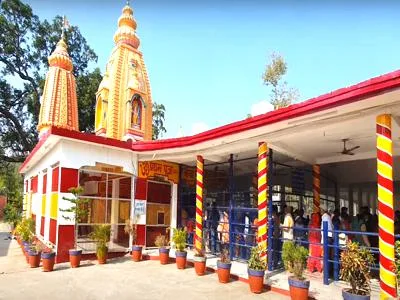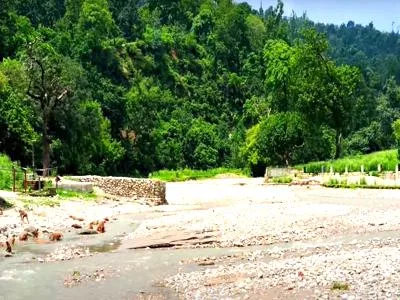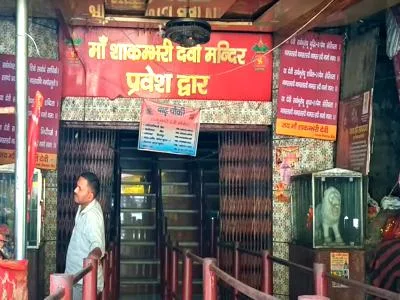Shakumbhari Devi Temple
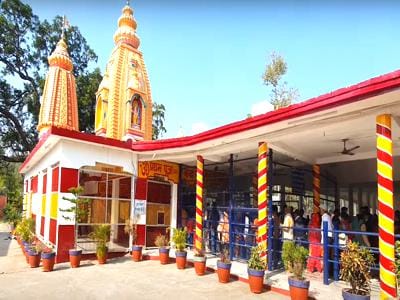
Shakumbhari Devi Temple
Shakumbhari Devi Temple is a famous temple dedicated to Mata Shakumbhari Devi, located in Saharanpur, Uttar Pradesh. The temple attracts pilgrims and tourists alike due to its rich history, spiritual significance and beautiful location. Known for its vibrant festivals and serene atmosphere, the temple holds an important place in Hindu mythology and cultural heritage.
Shakumbhari Devi Mandir
Shakumbhari Devi Mandir is a famous Hindu temple located near Saharanpur in Uttar Pradesh, India. Dedicated to Goddess Shakumbhari, an incarnation of Durga, the temple is surrounded by the beautiful Shivalik hills. Devotees believe the goddess blesses her followers with health, wealth, and happiness. The temple becomes especially vibrant during Navratri, attracting thousands of pilgrims from across the country. It is said that the goddess offered fruits and vegetables to the hungry during ancient times, earning the name “Shakumbhari” (meaning “vegetable goddess”). With spiritual energy and natural beauty, the temple offers peace and devotion to all who visit.
History: Shakumbhari Devi Saharanpur
Shakumbhari Devi Temple, located near Saharanpur in Uttar Pradesh, is an ancient and revered Hindu pilgrimage site dedicated to Goddess Shakumbhari, an incarnation of Goddess Durga. The temple’s history dates back to the Mahabharata era, with legends stating that the Goddess appeared to bless devotees and provide food during famine. Surrounded by the Shivalik hills, this sacred site attracts thousands of devotees, especially during Navratri. Shakumbhari Devi is worshipped as the “Goddess of Vegetables” and symbolizes nourishment and protection. The temple holds immense spiritual significance in Saharanpur and is an important religious destination in North India.
Significance of Shakumbhari Devi Mandir
Shakumbhari Devi Saharanpur is considered to be one of the major centers of worship of Mata Shakumbhari Devi. The temple is believed to bestow divine blessings to those seeking protection, good health and fulfillment of desires. According to Hindu mythology, the goddess is known to bless her devotees with abundance, especially in difficult times. Shakumbhari Devi Temple Saharanpur holds a special place in the hearts of devotees who visit here to seek the blessings of the goddess.
Main Deity
The main deity of Shakumbhari Devi Temple is Mata Shakumbhari Devi, who is depicted as a powerful form of Goddess Durga. She is often worshiped for her role in protecting nature and humanity. The Goddess is revered for her compassion and strength, and devotees seek her blessings for peace, prosperity, and overall well-being.
1. Bhora Dev Significance for Maa Shakumbhari Devi

Bhora Dev holds great significance in the worship of Maa Shakumbhari Devi. Local traditions emphasise Bhora Dev as the guardian deity of the Shakumbhari temple. Devotees believe that the deity protects the temple and ensures their safety and well-being. During Bhora Dev Puja, devotees pray and perform specific rituals to seek blessings from Maa Shakumbhari Devi and Bhora Dev. Devotees perform the puja with great reverence, invoking the divine energies of both deities to bring prosperity, peace and protection.
2. Festivals Celebrated at Shakumbhari Devi Mandir
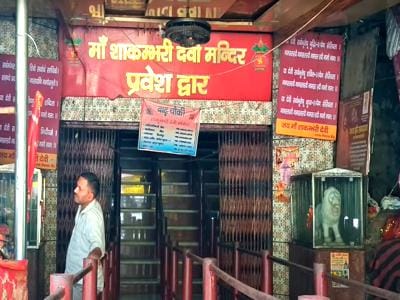
Grand celebrations are held at the Shakumbhari Devi Temple during several Hindu festivals. The most important is Navaratri, a nine-day festival that honors all forms of Goddess Durga, including Shakumbhari Devi. The temple is beautifully decorated and devotees gather in large numbers to offer prayers and seek blessings. Other festivals such as Vasant Panchami, Dussehra and Diwali are also celebrated with great enthusiasm at the temple, drawing large numbers of pilgrims to participate in religious rituals and festivities.
Guidelines for Visiting Shakumbhari Devi Mandir
1. General Behavior:
- Visitors are expected to maintain a respectful and peaceful demeanor while in the temple premises. Silence is preferred to enhance the spiritual experience.
2. Security Measures:
- The temple has tight security measures in place, including surveillance cameras and security personnel, to ensure the safety of all visitors. It is advisable to follow all safety protocols for a smooth visit.
3. Darshan Timings:
- Summer: The temple is open from 4 AM to 10 PM.
- Winter: The temple is open from 5 AM to 9 PM.
- Arti timings:
- During summer, the arti is performed at 4:30 AM or 5:00 AM in the morning and 7:00 PM or 7:30 PM in the evening.
- During winter, the arti is performed at 5:30 AM or 6:00 AM in the morning and 6:00 PM or 6:30 PM in the evening.
- Bhog time: Bhog time is from 11 AM to 11:15 AM daily.
4. Entry Passes:
- Entry to the Shakumbhari Devi Mandir Saharanpur is free of cost. However, donations are welcome, and they help maintain the temple and support various charitable activities.
5. Prohibited Items:
- Visitors should avoid carrying items such as leather goods, alcohol, or non-vegetarian food into the temple premises. These items are strictly prohibited as they go against the sanctity of the temple.
6. Photography and Videography:
- Photography is allowed in some areas of the temple but is restricted in the sanctum or near the main deity. Always seek permission from temple authorities before taking photos or videos to respect the temple’s spiritual ambiance.
7. Facilities:
- The temple offers several amenities for visitors, including clean restrooms, drinking water facilities, and a small prayer hall for peaceful contemplation. There are also small shops selling religious items such as incense, flowers, and offerings.
8. Health and Safety:
- While visiting, it is important to stay hydrated, especially during the summer months, as the area can get quite hot. The temple provides seating areas for visitors to rest and reflect. If you have any medical conditions, make sure to carry necessary medications.
9. Tips for Visitors:
- Wear Comfortable Clothing: Since visiting temples requires walking and standing for extended periods, it is advisable to wear comfortable clothing and footwear.
- Plan Your Visit During Weekdays: Weekends and festival days can get crowded. To avoid long queues, visit on weekdays.
- Respect Local Customs: Always follow local customs, such as removing shoes before entering the temple and offering prayers in a peaceful manner.
- Carry Offerings: While offerings like flowers and fruits are common, ensure they are in accordance with the temple’s customs.
- Parshad: Upon arriving at the main gate of the temple, you can purchase parshad from any of the nearby shops along the way. Alternatively, you are welcome to bring your own offerings from home, such as paan, supari, nariyal, halwa, laddo, and more.
- Avoid visiting during Vasant Panchami, Dussehra, and Diwali due to the heavy crowds.
Nearby Attractions
1. Pachmukhi Hanuman Temple
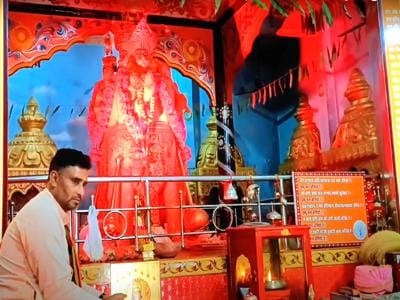
Panchmukhi Hanuman Temple, located in Saharanpur, Uttar Pradesh, is a prominent religious site. The temple honors Goddess Shakumbhari and features a unique Panchmukhi Hanuman idol, symbolizing Lord Hanuman’s five-faced form. Devotees believe it offers blessings of strength, protection, and spiritual upliftment. The temple is located around 2 to 3 km from Shakumbhari Devi Temple. Devotees visit to seek divine blessings and experience the peaceful ambiance of the temple.
2. Mansa Devi Temple
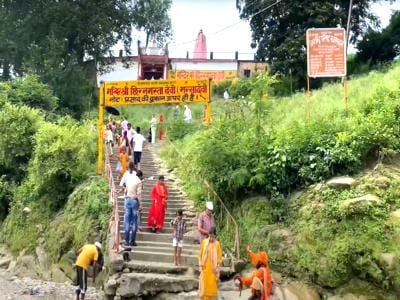
Mansa Devi Temple, located in Saharanpur, is just 0.3 km from Shakumbhari Devi Temple, making it a convenient spiritual destination for pilgrims. This temple, dedicated to Goddess Mansa Devi, fulfills the wishes of devotees who seek her divine blessings. The temple is a prominent religious site, attracting numerous visitors throughout the year. With its serene atmosphere and historical significance, Mansa Devi Temple offers a peaceful retreat for those seeking spiritual solace and blessings.
How to Reach Shakumbhari Devi Mandir ?
1. By Road (Car/Self-Drive):
- Distance: The distance between Shakumbhari Devi Mandir and Delhi is approximately 180 km.
- Travel Time: The travel time is typically 4 to 5 hours, depending on the traffic conditions and the route taken. The time can vary with weather conditions and the time of day.
- Route:
- Route 1: Delhi → Meerut (via NH334) → Muzaffarnagar → Saharanpur → Shakumbhari Devi Mandir.
- Route 2: Delhi → Ghaziabad → Meerut → Roorkee → Saharanpur → Shakumbhari Devi Mandir.
- Details:
- Start Point: Begin your journey from the city center, taking NH334 towards Meerut.
- Toll Plazas: There are several toll plazas along the route, so be prepared with cash or a FASTag.
- Food Stops: You’ll find plenty of restaurants and roadside dhabas in Meerut and Muzaffarnagar for food breaks.
- Fuel Stations: Fuel stations are easily available along the route, especially near major towns.
- Road Conditions: The road is generally in good condition, though there may be some minor traffic jams around Saharanpur.
- Best Time to Travel: For a smoother journey, leave early in the morning to avoid peak traffic hours, especially in Delhi and Meerut.
2. By Bus:
Reaching Shakumbhari Devi Mandir by bus is a convenient option for pilgrims and travelers. Direct and connecting buses are available from Delhi to the nearest bus stand near the temple.
- Nearest Bus Stand: Saharanpur Bus Stand is the nearest major bus stand. From here, local buses or taxis can take you to Shakumbhari Devi Mandir, approximately 40 km away.
- Travel Time:
- Delhi to Saharanpur: Approximately 5-6 hours.
- Saharanpur to Shakumbhari Devi Mandir: Another 1-1.5 hours.
- Type of Buses:
- State Transport Buses: Affordable and reliable; frequent UP Roadways buses are available.
- Private Buses: Offer AC and non-AC options with slightly higher ticket prices.
- Volvo/Deluxe Buses: Comfortable and faster, especially for families or groups.
- Route:
- Route: Delhi → Ghaziabad → Meerut → Muzaffarnagar → Saharanpur → Behat → Shakumbhari Devi Mandir.
- Most buses conclude their journey at Saharanpur, where you can easily access local transportation. To reach Shakumbhari Devi Mandir, board a connecting bus from Behat Adda in Saharanpur.
- Route: Delhi → Ghaziabad → Meerut → Muzaffarnagar → Saharanpur → Behat → Shakumbhari Devi Mandir.
- Details:
- Departure Points in Delhi: ISBT Kashmiri Gate and Anand Vihar Bus Terminal.
- Frequency: Buses to Saharanpur are frequent throughout the day.
- Food Stops: Most buses stop at designated dhabas or rest areas en route.
- Ticket Booking: Available online on platforms like RedBus, UPSRTC, and private operator websites.
- Tips: Book in advance during festive seasons as buses might get crowded.
3. By Air:
- Nearest Airport:
- The nearest airport to Shakumbhari Devi Mandir is Jolly Grant Airport in Dehradun (approximately 120 km away).
- Alternatively, you can also use Indira Gandhi International Airport in Delhi for more flight options, and then travel by road to the temple.
- Distance: The aerial distance from Delhi to Shakumbhari Devi Mandir is approximately 180 km. However, the total travel distance by road will be more.
- Travel Time:
- By Air: A flight from Delhi to Dehradun takes approximately 1 hour.
- By Road from Dehradun: From Jolly Grant Airport (87 KM), it takes about 2 to 3 hours by car to reach Shakumbhari Devi Mandir.
- Route:
- By Air: Take a flight from Indira Gandhi International Airport (Delhi) to Jolly Grant Airport (Dehradun).
- From Dehradun, take a cab or taxi to Shakumbhari Devi Mandir, following the route: Dehradun → Saharanpur → Shakumbhari Devi Mandir.
- Details:
- Flight Options: Several flights are available from Delhi to Dehradun, operated by airlines like Air India, IndiGo, and SpiceJet.
- Airport Transfers: Prepaid taxis and cabs are available at Jolly Grant Airport for onward travel to Shakumbhari Devi Mandir.
- Road Conditions: The road from Dehradun to Shakumbhari Devi Mandir is mostly well-maintained, but be prepared for some hilly terrain.
- Best Time to Travel: Flights are available throughout the day, but it’s advisable to book in advance, especially during peak seasons.
4. By Train:
- Nearest Railway Station: The nearest railway station to Shakumbhari Devi Mandir is Saharanpur Junction (Station Code: SRE). From Saharanpur, you can take a taxi or local transport to reach the temple, which is around 40 km away.
- Distance: The distance from Delhi to Shakumbhari Devi Mandir is approximately 180 km by train.
- Travel Time: The train journey from Delhi to Saharanpur takes around 3 to 6 hours, depending on the train service and schedule.
- Route:
- Route: Delhi → Saharanpur Junction → Local transport (Car / Taxi / Bus) to Shakumbhari Devi Mandir.
- Train Options: There are several trains from Delhi to Saharanpur, such as the Dehradun Shatabdi Express, Vande Bharat Express, Saharanpur Passenger, Saharanpur Janta Express, etc.
- Details:
- Departure Points in Delhi: You can board trains to Saharanpur from New Delhi Railway Station (NDLS), Hazrat Nizamuddin Railway Station (NZM), or Anand Vihar Terminal (ANVT).
- Train Types: Trains range from express services like Shatabdi Express to slower passenger trains, with the latter being more economical.
- Ticket Booking: Tickets can be booked online through the Indian Railways website or apps like IRCTC, and also through offline counters.
- Food & Facilities: Trains like Shatabdi offer meals on board, while other trains may have pantry services or stops for food.
- From Saharanpur to the Temple: After reaching Saharanpur Junction, you can take a taxi or local bus to Shakumbhari Devi Mandir, which will take about 1-1.5 hours.
Accommodation Options
1. Near Shakumbhari Devi Temple:
- Jila Parishad Guest House: Situated close to the Shakumbhari Devi Temple, this guest house offers basic amenities for pilgrims.
- Forest Department Guest House: Located near the Bhura Dev Temple, which is adjacent to the Shakumbhari Devi Temple, this guest house provides a convenient stay for devotees.
- Pulastya Wellness Resort Shakumbhari Devi: Approximately 21 kilometers from Shakumbhari Devi Temple, this 3-star resort offers amenities such as a garden, terrace, restaurant, and free Wi-Fi.
2. Behat (15–20 km from the temple)
- Basic lodges like Shakumbhari Lodge or Shree Krishna Guest House.
3. Saharanpur (40–50 km from the temple)
- Budget Hotels:
- Hotel City Palace, Hotel Shivalik, Hotel Raj (check recent reviews on platforms like MakeMyTrip or Goibibo).
- Mid-Range Options:
- Country Inn & Suites.
- Government Guesthouses:
- PWD Guesthouse or Forest Rest House (requires prior permission).
Travel Tips
- Book Early: Critical during Navratri (September/October and March/April).
- Amenities: Most options are basic; carry essentials like toiletries.
- Transport: Hire a taxi from Saharanpur (1.5–2 hours) or use local buses.
- Local Customs: Dress modestly and respect temple rituals.
- Weather: Summers (hot), monsoons (rainy), winters (pleasant).
🛕 Interesting Facts About Shakumbhari Devi Temple
- 1. Ancient Shaktipeeth
- Shakumbhari Devi Temple is considered an ancient Shaktipeeth, where Goddess Durga is worshipped in her form as Shakumbhari — the goddess who nourishes through vegetables, fruits, and greens.
- 2. Located in the Shivalik Hills
- The temple is nestled in the scenic Shivalik hills near Saharanpur, Uttar Pradesh. It is surrounded by lush forests, offering a serene and spiritual atmosphere.
- 3. Associated with Mahabharata Era
- Many believe that the temple dates back to the Mahabharata era, and the Pandavas visited this sacred place during their exile (vanvas).
- 4. Vegetarian Goddess
- Unlike many other forms of Durga, Shakumbhari Devi is strictly vegetarian. Devotees offer only vegetarian food, including seasonal fruits and vegetables — no animal sacrifice is allowed.
- 5. Navratri Fair
- During Navratri, especially in Chaitra and Sharad Navratri, a massive fair (mela) is held, drawing thousands of devotees who come to seek blessings and participate in religious festivities.
- 6. The Meaning of Shakumbhari
- The name “Shakumbhari” comes from “Shaka” (vegetables) and “Bhoomi” (earth), symbolizing the goddess as the nurturer of life through vegetation.
- 7. Sacred Water Pond
- A small pond near the temple is considered sacred, and pilgrims take a dip in it before entering the temple, believing it purifies their body and soul.
- 8. Believed to Cure Diseases
- Many devotees believe that praying to Shakumbhari Devi can heal diseases, especially those related to malnutrition or food-related issues.
- 9. Vibrant Folk Culture
- The area around the temple is rich in folk songs and local traditions dedicated to the goddess, especially sung during the yatra (pilgrimage).
- 10. Free Community Meals (Bhandara)
- Like many Hindu temples, this one too often offers free community meals (bhandara) to all devotees, especially during special occasions.

